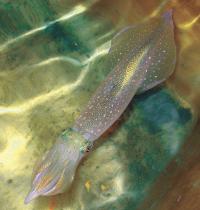
Loligo pealei, the Atlantic squid, has a giant axon that runs the length of its mantle. By injecting designer nanobeads into the giant axon mimicking endogenous cargo, researchers at Brown University and the Marine Biological Laboratory discovered a peptide within amyloid precursor protein that can hitch cargo inside neurons for transport to the synapse. Credit Russell Jacobs and Elaine Bearer/Marine Biological Laboratory. For the first time, researchers have identified a peptide that can spur cargo transport in nerve cells, a discovery that could help scientists better understand nerve cell function and test possible therapies for neurodegenerative diseases.
Elaine Bearer, a professor at Brown Medical School, led the research, which was conducted at the MBL (Marine Biological Laboratory) in Woods Hole, Mass., where Bearer was a Dart Scholar and is a Whitman investigator. Published in the Proceedings of the National Academy of Sciences online early edition, the research shows that a peptide, or protein bit, can hitch biological material onto molecular motor machinery, acting as a "ZIP Code" that directs the shipment to the synapse.
The peptide comes from amyloid precursor protein, or APP, a principal component of plaques found in the brains of people with Alzheimer's disease. Scientists have long known that APP can break down and form these plaques and that mutations in this protein lead to early onset of Alzheimer's disease. Until now, however, little was understood about the function of APP in healthy nerve cells.
The research also sheds light on the complex intracellular transport system inside nerve cells. This transport system is critical to nervous system function, bringing proteins and RNA from the cell body down a neuron's spindly axon to the synapse, the major site of information exchange and storage in the nervous system. Without this precious cargo, neurons can't communicate. Memories can't be made. Learning can't take place. And neurons die.
"This neuronal transport system is incredibly important, but until now, we didn't know what actually attaches the cargo to the motor and gives it a 'ZIP Code' or address to ship it to. Our work shows that the cargo-motor hitch is as simple as a short peptide," Bearer said. "We've identified the first of these molecular dispatchers – a short peptide from the Alzheimer's protein APP."
At Brown, Bearer studies molecular transport through the herpes simplex virus (HSV), which travels inside neurons between the cell body and synapse. At her MBL laboratory, she studies the general mechanisms governing transport by injecting fluorescently labeled virus into the giant axon of the squid.
Aside from being a seafood delicacy, squid have a giant axon, or nerve cell fiber, that is 1,000 times wider than the average human axon, making it much easier to see and work with. For more than 75 years, squid have helped MBL scientists demystify important nervous system functions, such as how nerve cells communicate; how proteins, organelles, and other cargoes are transported along the axon; and how nerves conduct electricity. Since all life forms have similar basic cellular functions, scientists can translate what they learn from a simple system like the squid's to the more complex system in humans.
The Bearer lab has already shown that APP is physically associated with the herpes virus during anterograde transport, or the movement from the cell body to the synapse. In this new work, Bearer wanted to test whether APP was capable of mediating this movement.
In the lab, Bearer and her team substituted fluorescent beads for virus and coated them with chemically synthesized peptides based on the sequence of human and squid APP. The squid sequence was obtained through a new squid genome project initiated at MBL by study co-author Joseph DeGiorgis. Bearer and her team injected the beads into squid axon then watched through a microscope. Would the beads move? If they did, what path did they take? And where would they wind up?
After testing seven different peptides, Bearer and her team found that only one, a short peptide from APP, which they called APP-C, made the beads move quickly down the axon to the synapse. What's particularly compelling about the finding, Bearer said, is that APP-C in squid can be found in a nearly identical form in humans, worms and fruit flies, making it likely that the peptide plays a universal role in cargo trafficking inside neurons and other cells.
The peptide tag could be used to tag protein therapy aimed at repairing synapses damaged by disease or by poisons such as lead. Scientists could use the tag as a research tool to help them better understand nerve cell transport. It might also be also be used in diagnostic studies to determine whether and how much transport has been affected by dementia or to trace normal or abnormal neuronal circuits.
Bearer said the research results point to APP transport as a possible drug target for Alzheimer's, Huntington's and other diseases characterized by a breakdown in nerve cell transport.
"We've created a protein delivery system that we can use for all kinds of basic bench research as well as to test biomedical therapies," Bearer said. "The possibilities are exciting." Source : Brown University
 Print Article
Print Article Mail to a Friend
Mail to a Friend
